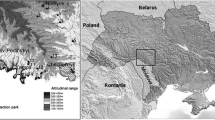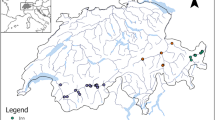Abstract
Productivity–species diversity relationships have been a controversial research topic in ecology with scale believed to be among the main reasons for discovering different relationships. We collected data on species diversity (richness) and productivity (peak above-ground biomass) of the Stipa breviflora association in the Inner Mongolia grassland to examine spatial scale dependency and possible underlying mechanisms responsible for the relationships found. One local and seven different landscape scales (the first level corresponds in extent to a 100 × 100 km area, which is increased consecutively by 100 km resulting in the 700 × 700 km area at the highest level) were considered. We found that: (1) unimodal relationships dominated the local scale, but this varied depending on the position along successional gradients; (2) a positive linear relationship was common at larger spatial scales; (3) biotic processes were the most likely primary factor underlying local scale unimodal relationships, but environmental heterogeneity (precipitation patterns) was the main determinant of relationships found at larger spatial scales; (4) our study contributed to other empirical evidence and predictions of theoretical models regarding scale dependency of productivity–species richness relationships; (5) while earlier research demonstrated positive linear species richness–productivity relationships across a number of ecological scales in the Inner Mongolia steppe, our study specifically tested a spectrum of geographical scales to confirm the scale-dependency of this relationship. Lastly, our study emphasized the critical role played by precipitation patterns in controlling biodiversity and grassland ecosystem functioning, which maintains the relatively high level of biodiversity and stable ecosystem processes.






Similar content being viewed by others
References
Abrams P (1995) Monotonic or unimodal diversity–productivity gradients: what does competition theory predict? Ecology 76:2019–2027
Bai YF, Han XG, Wu J, Chen ZZ, Li LH (2004) Ecosystem stability and compensatory effects in the Inner Mongolia grassland. Nature 431:181–184
Bai YF, Wu JG, Pan QM, Huang JH, Wang QB, Li FS, Buyantuyev A, Han XG (2007) Positive linear relationship between productivity and diversity: evidence from the Eurasian Steppe. J Appl Ecol 44:1023–1034
Bai YF, Wu JG, Xing Q, Pan QM, Huang JH, Yang DL, Han XG (2008) Primary production and rain use efficiency across a precipitation gradient on the Mongolia plateau. Ecology 89:2140–2153
Bai YF, Wu JG, Clark CM, Naeem S, Pan QM, Huang JH, Zhang LX, Han XG (2010) Tradeoffs and thresholds in the effects of nitrogen addition on biodiversity and ecosystem functioning: evidence from inner Mongolia Grasslands. Global Change Biol 16:358–372
Beyer H (2004) Hawth’s analysis tools for ArcGIS. http://www.spatialecology.com/htools
Bond EM, Chase JM (2002) Biodiversity and ecosystem functioning at local and regional spatial scales. Ecol Lett 5:467–470
Boyero L, Pearson RG, Bastian M (2007) How biological diversity influences ecosystem function: a test with a tropical stream detritivore guild. Ecol Res 22:551–558
Chalcraft DR, Williams JW, Smith MD, Willig MR (2004) Scale dependence in the species-richness–productivity relationship: the role of species turnover. Ecology 85:2701–2708
Chase JM, Leibold MA (2002) Spatial scale dictates the productivity–biodiversity relationship. Nature 416:427–430
Coupland RT (1993) Ecosystems of the world 8B. Natural grasslands: eastern hemisphere and Résumé. Elsevier, Amsterdam
Evans KL, Newson SE, Storch D, Greenwood JJD, Gaston KJ (2008) Spatial scale, abundance and the species–energy relationship in British birds. J Anim Ecol 77:395–405
Gillman LN, Wright SD (2006) The influence of productivity on the species richness of plants: a critical assessment. Ecology 87:1234–1243
Gough L, Grace JB, Taylor KL (1994) The relationship between species richness and community biomass: the importance of environmental variables. Oikos 70:271–279
Grime J (1973) Control of species density in herbaceous vegetation. J Environ Manage 1:151–167
Gross KL, Willig MR, Gough L, Inouye R, Cox SB (2000) Patterns of species density and productivity at different spatial scales in herbaceous plant communities. Oikos 89:417–427
Guo QF (2003) Temporal species richness–biomass relationships along successional gradients. J Veg Sci 14:121–128
Guo QF, Berry WL (1998) Species richness and biomass: dissection of the hump-shaped relationships. Ecology 79:2555–2559
Harrison S, Davies KF, Safford HD, Viers JH (2006) Beta diversity and the scale-dependence of the productivity–diversity relationship: a test in the Californian serpentine flora. J Ecol 94:110–117
Hooper D, Vitousek P (1997) The effects of plant composition and diversity on ecosystem processes. Science 277:1302
Huxman TE, Snyder KA, Tissue D, Leffler AJ, Ogle K, Pockman WT, Sandquist DR, Potts DL, Schwinning S (2004) Precipitation pulses and carbon fluxes in semiarid and arid ecosystems. Oecologia 141:254–268
Inner Mongolia-Ningxia Joint Inspection Group of Chinese Sciences of Academy (1985) Vegetation of Inner Mongolia. Science, Beijing
IPCC (2007) Climate change 2007: the physical science basis. Cambridge University Press, Cambridge
Isbell FI, Polley HW, Wilsey BJ (2009) Biodiversity, productivity and the temporal stability of productivity: patterns and processes. Ecol Lett 12:443–451
Jiang XL, Zhang WG, Wang G (2007) Effects of different components of diversity on productivity in artificial plant communities. Ecol Res 22:629–634
Kassen R, Buckling A, Bell G, Rainey P (2000) Diversity peaks at intermediate productivity in a laboratory microcosm. Nature 406:508–512
Klironomos JN, McCune J, Hart M, Neville J (2000) The influence of arbuscular mycorrhizae on the relationship between plant diversity and productivity. Ecol Lett 3:137–141
Laughlin DC, Moore MM (2009) Climate-induced temporal variation in the productivity–diversity relationship. Oikos 118:897–902
Levin S (1992) The problem of pattern and scale in ecology. Ecology 73:1943–1967
Ma WH, He JS, Yang YH, Wang XP, Liang CZ, Anwar M, Zeng H, Fang JY, Schmid B (2010) Environmental factors covary with plant diversity–productivity relationships among Chinese grassland sites. Global Ecol Biogeogr 19:233–243
Meehl GA, Arblaster JM, Tebaldi C (2005) Understanding future patterns of increased precipitation intensity in climate model simulations. Geophys Res Lett 32:L18719
Mitchell-Olds T, Shaw R (1987) Regression analysis of natural selection: statistical inference and biological interpretation. Evolution 41:1149–1161
Mittelbach GG, Steiner CF, Scheiner SM, Gross KL, Reynolds HL, Waide RB, Willig MR, Dodson SI, Gough L (2001) What is the observed relationship between species richness and productivity? Ecology 82:2381–2396
Moore DRJ, Keddy PA (1988) The relationship between species richness and standing crop in wetlands: the importance of scale. Plant Ecol 79:99–106
Naeem S (2002) Ecosystem consequences of biodiversity loss: the evolution of a paradigm. Ecology 83:1537–1552
Naeem S, Thompson LJ, Lawler SP, Lawton JH, Woodfin RM (1994) Declining biodiversity can alter the performance of ecosystems. Nature 368:734–737
Naeem S, Hakansson K, Lawton JH, Crawley MJ, Thompson LJ (1996) Biodiversity and plant productivity in a model assemblage of plant species. Oikos 76:259–264
Ni J, Wang GH, Bai YF, Li XZ (2007) Scale-dependent relationships between plant diversity and above-ground biomass in temperate grasslands, south-eastern Mongolia. J Arid Environ 68:132–142
Niu JM (2001) Climate-based digital simulation on spatial distribution of vegetation—a case study in Inner Mongolia. Acta Ecol Sin 21:1064–1071
Rosenzweig ML (1995) Species diversity in space and time. Cambridge University Press, Cambridge
Sala OE, Austin AT (eds) (2000) Methods of estimating aboveground net primary productivity. Springer, New York
Sala OE, Lauenroth WK, Parton WJ (1992) Long-term soil water dynamics in the shortgrass steppe. Ecology 73:1175–1181
Schwinning S, Sala OE (2004) Hierarchy of responses to resource pulses in and semi-arid ecosystems. Oecologia 141:211–220
Tilman D (1999) The ecological consequences of changes in biodiversity: a search for general principles. Ecology 80:1455–1474
Tilman D (2000) Causes, consequences and ethics of biodiversity. Nature 405:208–211
Waide RB, Willig MR, Steiner CF, Mittelbach G, Gough L, Dodson SI, Juday GP, Parmenter R (1999) The relationship between productivity and species richness. Annu Rev Ecol Syst 30:257–300
Wheeler BD, Giller KE (1982) Species richness of herbaceous fen vegetation in Broadland, Norfolk in relation to the quantity of above-ground plant material. J Ecol 70:179–200
Wu J (1999) Hierarchy and scaling: extrapolating information along a scaling ladder. Can J Remote Sens 25:367–380
Wu J, Levin S (1994) A spatial patch dynamic modeling approach to pattern and process in an annual grassland. Ecol Monogr 64:447–464
Wu J, Loucks O (1995) From balance of nature to hierarchical patch dynamics: a paradigm shift in ecology. Q Rev Biol 70:439
Wu J, Jones B, Li H, Loucks OL (eds) (2006) Scaling and uncertainty analysis in ecology: methods and applications. Springer, Dordrecht
Zobel M, Partel M (2008) What determines the relationship between plant diversity and habitat productivity? Global Ecol Biogeogr 17:679–684
Acknowledgments
We are very grateful to Dr. Bo Li of the Editorial Board of Ecological Research and two anonymous reviewers for their constructive comments. We also thank Christopher Clark for improving the quality of our manuscript. This work was supported by the National Basic Research Program of China (30760158) and the State Key Basic Research Development Program of China (2007CB106807).
Author information
Authors and Affiliations
Corresponding author
About this article
Cite this article
Zhang, Q., Niu, J., Buyantuyev, A. et al. Productivity–species richness relationship changes from unimodal to positive linear with increasing spatial scale in the Inner Mongolia steppe. Ecol Res 26, 649–658 (2011). https://doi.org/10.1007/s11284-011-0825-4
Received:
Accepted:
Published:
Issue Date:
DOI: https://doi.org/10.1007/s11284-011-0825-4




